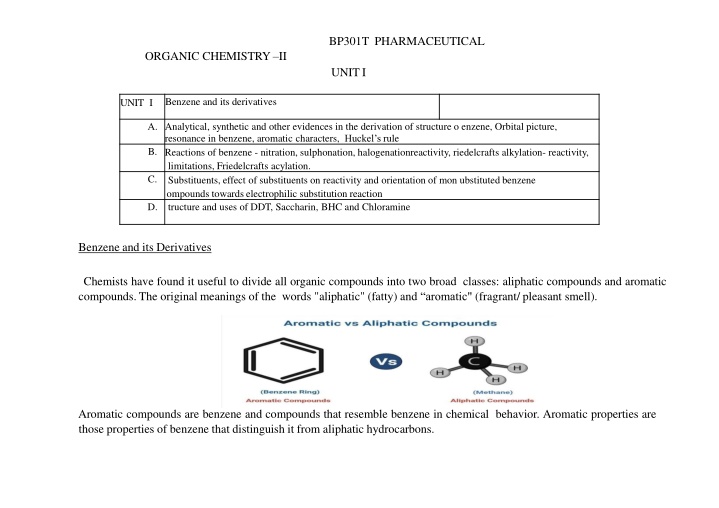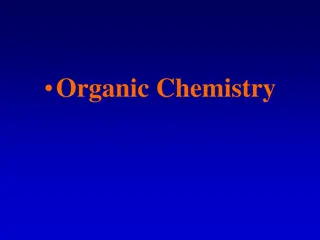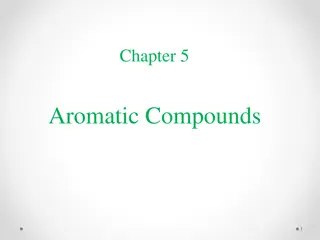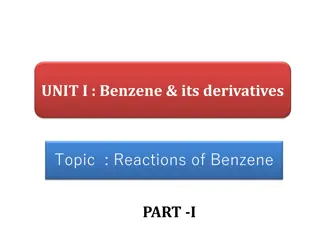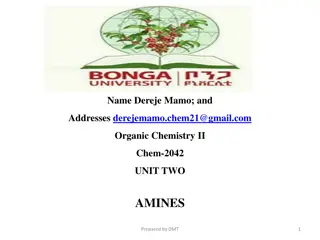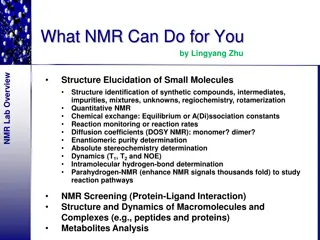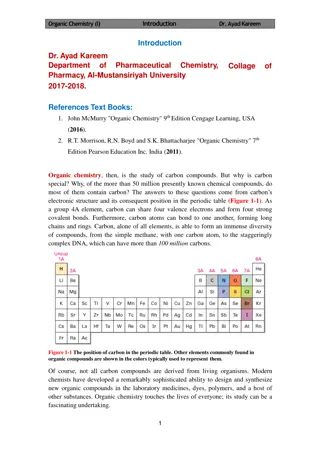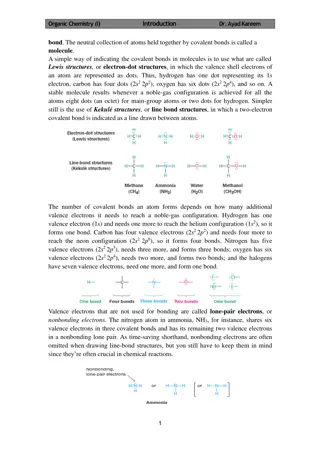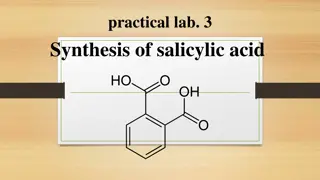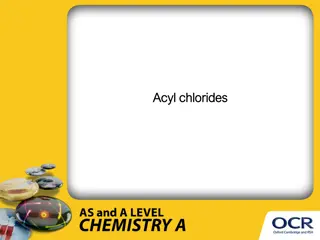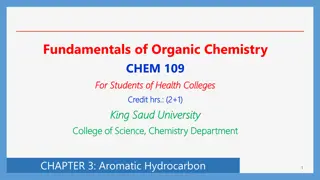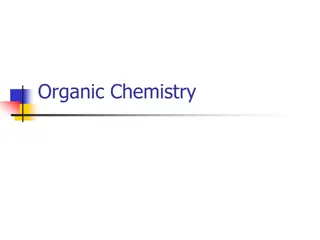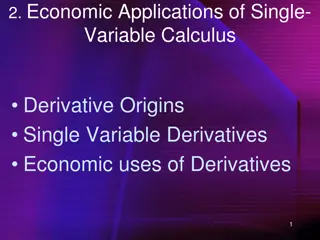Organic Chemistry II: Benzene and Its Derivatives
Chemists distinguish between aliphatic and aromatic compounds, with benzene being a key aromatic compound. Explore the structure, properties, and uses of benzene, including its historical significance and synthetic derivations.
Download Presentation

Please find below an Image/Link to download the presentation.
The content on the website is provided AS IS for your information and personal use only. It may not be sold, licensed, or shared on other websites without obtaining consent from the author.If you encounter any issues during the download, it is possible that the publisher has removed the file from their server.
You are allowed to download the files provided on this website for personal or commercial use, subject to the condition that they are used lawfully. All files are the property of their respective owners.
The content on the website is provided AS IS for your information and personal use only. It may not be sold, licensed, or shared on other websites without obtaining consent from the author.
E N D
Presentation Transcript
BP301T PHARMACEUTICAL ORGANIC CHEMISTRY II UNITI Benzene and its derivatives UNIT I A. Analytical, synthetic and other evidences in the derivation of structure o enzene, Orbital picture, resonance in benzene, aromatic characters, Huckel s rule B. Reactions of benzene - nitration, sulphonation, halogenationreactivity, riedelcrafts alkylation- reactivity, limitations, Friedelcrafts acylation. C. Substituents, effect of substituents on reactivity and orientation of mon ubstituted benzene ompounds towards electrophilic substitution reaction D. tructure and uses of DDT, Saccharin, BHC and Chloramine Benzene and its Derivatives Chemists have found it useful to divide all organic compounds into two broad classes: aliphatic compounds and aromatic compounds. The original meanings of the words "aliphatic" (fatty) and aromatic" (fragrant/ pleasant smell). Aromatic compounds are benzene and compounds that resemble benzene in chemical behavior. Aromatic properties are those properties of benzene that distinguish it from aliphatic hydrocarbons.
Benzene: It was formerly used to decaffeinate coffee and component of many consumer products, such as paint strippers, rubber cements, and home dry-cleaning spot removers. Aprecursor in the production of plastics (such as Styrofoam and nylon), drugs, detergents, synthetic rubber, pesticides, and dyes. It is used as a solvent in cleaning and maintaining printing equipment and for adhesives such as those used to attach soles to shoes. Benzene is a natural constituent of petroleum products, but because it is a known carcinogen, its use as an additive in gasoline is now limited. In 1970s it was associated with leukemia deaths. A liquid that smells sweet, aromatic like gasoline. Boils at 80 C & Freezes at 5.5 C. Structure of benzene History, Analytical, Synthetic and other evidences in the derivation of structure of benzene: (a) Historyof benzene: Isolated in 1825 by Michael Faraday who determined C:H ratio to be 1:1. Synthesizedin 1834byEilhardMitscherlichwho determinedmolecularformulato be C6H6. He named it benzin later known as benzene. (b) Benzene has the molecular formula C6H6. The question was: how are these atoms arranged? The molecular formula of benzene has been found from analytical data, to be C6H6. Relatively higher proportion of carbon and addition of chlorine to benzene molecule indicate it to be an unsaturated compound. Depending on the various facts available to scientists fromtime to time, many structures forbenzenehad been proposed.Some are described below. 2
Open Chain Structure Baseduponobservablefactsgivenaboveand thetetravalencyofcarbon,thefollowing open chain structures were proposed for benzene. Drawbacks of open chain structure: The open chain structure for benzene was rejected due to the following reasons: Addition reactions usually given by alkenes and alkynes are not given by benzene. Benzene forms only one kind of mono-substituted product. An open chain structure however, can form more than one kind of mono-substituted product as shown below: The open chain compounds do, not give reactions such as Friedel Craft reaction, nitration, sulphonation. On reduction with hydrogen in the presence of Ni at 200 C, actually a cyclic compound cyclohexane is obtained. In 1858, August Kekule (of the University of Bonn) had proposed that carbon atoms can join to one another to form chains. Then, in 1865, he offered an answer to the question of benzene: these carbon chains can. Sometimes be closed, to formrings. Kekule's structure of benzene was one that we would represent today as 3
All the carbon-to-carbon bonds in benzene are equivalent The molecule is unusually stable Chemists often represent benzene as a hexagon with an inscribed circle Theinnercircleindicatesthatthevalenceelectronsaresharedequallybyallsixcarbon atoms (that is, the electrons are delocalized, or spread out, over all the carbon atoms). Each corner of the hexagon is occupied by one carbon atom, and each carbon atom has one hydrogen atom attached to it. Any other atom or groups of atoms substituted for a hydrogen atom must be shown bonded to a particular corner of the hexagon. The six bond lengths are identical and they are one-and-a half bonds and their length, 1.39 A or 139 picometer (pm), is intermediate between the lengths of single and double bonds (is shorter than typical single-bond lengths, yet longer than typical double-bond lengths). An orbital model for the benzene structure Building the orbital model Benzene is built from hydrogen atoms (1s1) and carbon atoms (1s22s22px12py1). Each carbon atom has to join to three other atoms (one hydrogen and two carbons) and doesn't have enough unpaired electrons to form the required number of bonds, so it needs to promote one of the 2s2 pair into the empty 2pz orbital. 4
Promotion of an electron There is only a small energy gap between the 2s and 2p orbitals, and an electron is promoted from the 2s to the empty 2p to give 4 unpaired electrons. The extra energy released when these electrons are used for bonding more than compensates for the initial input. The carbon atomis now said to be in an excited state. Hybridisation Because each carbon is only joining to three other atoms, when the carbon atoms hybridise their outer orbitals before forming bonds, they only need to hybridise three of the orbitals rather than all four. Theyusethe2s electronandtwoofthe2p electrons, but leave the other 2p electron unchanged. The new orbitals formed are called as sp2 hybrids, because they are made by an s orbital and two p orbitals reorganizing themselves. Three sp2 hybrid orbitals arrange themselves as far apart as possible which is at 120 to each other in a plane. The remaining p orbital is at right angles to them. Eachcarbonatomnowlookslikethediagramontheright.Thisis thesame as happens in ethene. The difference in benzene is that each carbon atom is joined to two other similar carbon atoms instead of just one. Each carbon atom uses the sp2 hybrids to form sigma bonds with two other carbons and one hydrogen atom. The next diagram shows the sigma bonds formed, but for the moment leaves the p orbitals alone. 5
Since sigma bond results from the overlap of above said planar orbital, all H and C atoms are in the same plane and their generate a hexagonal ring of C atoms. Each C atom in benzene also has an unhybrid 2pz orbital containing one electron. These 2pz orbital are perpendicular to the plane of sigma bonds. Actually these 2pz orbital produce a (pi) molecular orbital containing six electrons. One half of this (pi) molecular orbital lies above the plane of hexagonal ring and remaining half below the ring like a sandwich. 6
The overlap of these 2pz orbital results in the formation of a fully delocalized (pi) bond, which extends all over the six C atoms of benzene nucleus. The molecular orbital approach clearly indicates that these six electrons could be found anywhere in highly delocalized manner. As a result of delocalization, a stronger (pi) bond and a more stable benzene molecule is obtained which undergo substitution reactions more frequentlythan addition reactions. Benzene is a flat molecule, with every carbon and hydrogen lying in the same plane these bonds are designated as a sigma ( ) bonds. Each sp2hybridized C in the ring has an unhybridized p orbital perpendicular to the ring which overlaps around the ring. The six pi ( ) electrons are delocalized over the six carbons. Benzene yields only one monosubstitution product, C6H5Y. Only one (c) bromobenzene, C6H5Br, is obtained when one hydrogen atom is replaced by bromine; similarly, only one chlorobenzene, C6H5C1, or one nitrobenzene, C6H5NO2, etc., has ever been made. This fact places a severe limitation on the structure of benzene: each hydrogen must be exactly equivalent to every other hydrogen, since the replacement of any one of them yields the same product. Benzeneyieldsthreeisomericdisubstitutionproducts,C6H4Y2orC6H4YZ.e.g. (d) like only three isomeric dibromobenzenes, C6H4Br2, three chloronitrobenzenes, C6H4ClNO2, etc. This fact further limits our choice of a structure to Kekule's structure of benzene compare to any other structures with the molecular formula C 6H6. The relative positions of two substituents on a benzene ring can be indicated either by numbers or by the prefixes ortho, meta, and para. Adjacent substituents are called ortho, substituents separated by one carbon are called meta, and substituents located opposite one another are designated para. Often, only their abbreviations (o, m, p) are used in naming compounds. 7
However, that two 1,2-dibromo isomers differing in the positions of bromine relative to the double bonds, should be possible: On the other hand, it is believed by some that Kekule had unthinkingly anticipated our present concept of delocalized electrons, and drew two pictures (as shown above). The currently accepted structure did not arise from the discovery of new facts about benzene, but it is the result of an extension or modification of the structural theory; this extension is the concept of resonance. OR Resonance: structures that differ only in the arrangement of electrons. Benzene is a hybrid of I and II. Since; I and II are exactly equivalent, and hence of exactly the same stability, they make equal contributions to the hybrid. Stability: The most striking evidence to unusual stability of benzene ring is found in the chemical reactions of benzene & the heat released in a hydrogenation reaction of one mole of an unsaturated compound. Benzene undergoes substitution rather than addition. Kekule's structure of benzene is one that we would call "cyclohexatriene." We would expect this cyclohexatriene, like the very similar compounds, cyclohexadiene and cyclohexene, to undergo readily the addition reactions characteristic of the alkene structure. Example: cyclohexene an alkene undergoes rapid addition reaction, under same conditions were benzene reacts either not at all or very slowly and this exhibited a 8
high degree of unusual chemical stability of benzene compared with known alkenes and cycloalkenes (aliphatic compounds). Example: In addition reaction an alkene reacts with an electrophile, thereby forming a carbocation intermediate. In the second step ofanelectrophilicadditionreaction,the carbocation reacts with a nucleophile to form an addition product. If the carbocation intermediate formed from the reaction of benzene with an electrophile were to react similarly with a nucleophile (depicted as event b in Figure below), the addition product would not be aromatic. If, however, the carbocation loses a proton from the site of electrophilic attack (depicted as event an in Figure below), the aromaticity of the benzene ring is restored. Because the aromatic product is much more stable than the nonaromatic addition product, the overall reaction is an electrophilic substitution reaction rather than an electrophilic addition reaction. In the substitution reaction, an electrophile substitutes for one of the hydrogens attached to the benzene ring. 9
In place of addition reactions, benzene readily undergoes a new set of reactions, all involving substitution. The most important are Halogenation, Nitration, Sulfonation, Friedel Crafts acylation & Friedel Crafts alkylation. In an electrophilic aromatic substitution reaction, an electrophile is put on a ring carbon, and the H+comes off the same ring carbon. The heat of hydrogenation (resonance energy) and combustion. The heat released in a hydrogenation reaction of one mole of an unsaturated (double- bonded) compound is called the heat of hydrogenation. A quantitative data which shows how much more stable is benzene. Cyclohexene has a heat of hydrogenation of 28.6 kcal and cyclohexadiene has one about twice that (55.4 kcal.) We expected cyclohexatriene (i.e. imagine that benzene contains three double bonds in it) to have a heat of hydrogenation about three times as large as cyclohexene, that is, about 85.8 kcal. Actually, the value for benzene (49.8 kcal) is 36 kcal less than this expected amount. The fact that benzene evolves 36 kcal less energy than predicted can only mean that benzene contains 36 kcal less energy than predicted; in other words, benzene is more stable by 36 kcal than we would have expected cyclohexatriene to be. 10
Aromatic character:The Huckel 4n + 2 rule In 1931, German chemist and physicist Erich H ckel proposed a theory to help determine if a planar ring molecule would have aromatic properties. His rule states that if a cyclic, planar molecule has 4n+2 (Pi) electrons, it is considered aromatic. This rule would come to be known as H ckel's Rule. Criteria forAromaticity &Anti-Aromaticity: Aromatic Anti-aromatic Non-aromatic The molecule is cyclic (a ring The molecule is cyclic (a ring of atoms) of atoms) The molecule is planar or flat The molecule is planar or flat (all atoms in the molecule lie in (all atoms in the molecule lie Fails any one of the the same plane) in the same plane) criteriaon The molecule is The molecule is the left fully conjugated (p orbitalsat fully conjugated (p orbitalsat OR every atom in the ring) every atom in the ring) everything else The molecule has 4n+2 The molecule has 4n electrons (n=0 or any positive integer) Electrons 11 Unusuallystable Unusuallystable
Cyclobutadiene Benzene Cyclooctatetraene Resonance energy (heat of hydrogenation energy) 36 kcal/mol Only stable below - 100 C According to H ckel's Molecular Orbital Theory, a compound is particularly stable if all of its bonding molecular orbitals are filled with paired electrons. With aromatic compounds, 2 electrons fill the lowest energy molecular orbital, and 4 electrons fill each subsequent energy level (the number of subsequent energy levels is denoted by n) leaving all bonding orbitals filled and no anti-bonding orbitalsoccupied. This gives a total of 4n+2 electrons. In benzene, each double bond ( bond) always contributes 2 electrons. Benzene has 3 double bonds, so it has 6 electrons. Its first 2 electrons fill the lowest energy orbital, and 4 electrons remaining fill in the orbitals of the succeeding energy level. Notice how all of its bonding orbitals are filled, but none of the anti-bonding orbitals have any electrons. 12
To apply the 4n+2 rule, first count the number of electrons in the molecule. Then, set this number equal to 4n+2 and solve for n. If is 0 or any positive integer (1, 2, 3,...), the rule has been met. For example, benzene has six electrons: 4n+2=6 4n=4 n=1 For benzene, we findthat n=1, whichis a positive integer,so the rule is met. benzene is aromatic compound. Aromatic Ions H ckel's Rule also applies to ions especially aromatic ions. As long as a compound has 4n+2 electrons, it does not matter if the molecule is neutral or has a charge. For example, cyclopentadienyl anion is an aromatic ion. Carbons 2-5 are sp2 hybridized because they have 3 attached atoms and have no lone electron pairs. If an atom has 1 or more lone pairs and is attached to an sp2 hybridized atom, then that atomis sp2 hybridized also. Therefore,carbon1 alsosp2hybridized,it has a p orbital.Cyclopentadienylanion has 6 electrons and fulfills the 4n+2 rule. HeterocyclicAromatic Compounds 13
Heterocyclic compounds contain 1 or more different atoms other than carbon in the ring. Acommon example is furan, which contains an oxygen atom. All carbons in furan are sp2hybridized. The oxygen has at least 1 lone electron pair and is attached to an sp2 hybridized atom, so it is sp2hybridized as well. Notice how oxygen has 2 lone pairs of electrons. How many of those electrons are electrons? A sp2hybridized atom only has 1 p orbital, which can only hold 2 electrons, so we know that 1 electron pair is in the p orbital, while the other pair is in an sp2orbital. So, only 1 of oxygen's 2 lone electron pairs are electrons. So, Furan has 6 electrons and fulfills the 4n+2 rule. Working example I: Using the criteria for aromaticity, determine if the following molecules are aromatic: Reactions of Benzene: 14
Nikita Kumari Assistant Professor SOPS, CT University Benzene readily undergoes a new set of reactions, all involving substitution i.e. Electrophilic Aromatic Substitution Reactions. It involves the reaction of an electrophile with an aromatic compound, were electrophile substitutes for a hydrogen of an aromatic compound. General Mechanism for ElectrophilicAromatic Substitution Reactions: Similar to alkenes, benzene (aromatics) has a cloud of electrons available to attack electrophiles (the aromatic ring is nucleophilic) The resulting carbocation is stabilized by resonance and is called: Sigma complex. These reactions are greatly facilitated by the addition of a Lewis acid catalyst. Key bonds formed C-Y and key bonds are broken C-H Electron donating substituents increase the rate of substitution reaction by activating the benzene ring to electrophilic attack. Electron withdrawing substituents decrease the rate of substitution reaction by deactivating the benzene ring to electrophilic attack. The general mechanism can be applied to the following reactions and the only difference will be the nature of the electrophile, and how it is formed. 1. Halogenation: A bromine (Br), a chlorine (Cl), or an iodine (I) substitutes for a hydrogen (Lewis acid: AlCl3/FeCl3/AlBr3/FeBr3, etc.) 2. Nitration:Anitro (NO2) group substitutes for a hydrogen (acid: H2SO4). 3. Sulfonation:Asulfonic acid (SO3H) group substitutes for a hydrogen (acid: H2SO4). 4. Friedel Crafts acylation: An acyl (RC=O) group substitutes for a hydrogen (Lewis acid:AlCl3/FeCl3) 5. Friedel Crafts alkylation: an alkyl (R) group substitutes for a hydrogen (Lewis acid: AlCl3/FeCl3) 15
Halogenation of Benzene: The bromination or chlorination of benzene requires a Lewis acid such as ferric bromide or ferric chloride. Recall that a Lewis acid is a compound that accepts a share in a pair of electrons. Bromination: Electrophile Br+ Chlorination: Electrophile Cl+ Iodination: For iodination, iodine is simply oxidized with nitric acid (HNO3) to liberate the I+, which is then used as the electrophile. 16
H++ HNO3 + I2 I++ NO2 + H2O OR Nitration of Benzene: acid as a catalyst. Nitration of benzene with nitric acid requires sulfuric Electrophile: Sulfonation of Benzene: Fuming sulfuric acid (a solution of in sulfuric acid) or concentrated sulfuric acid is used to sulfonate aromatic rings. Electrophile: HSO3+ 17
Sulfonation of benzene is a reversible reaction. If benzenesulfonic acid is heated in dilute acid, the reaction proceeds in the reverse direction. Friedel CraftsAcylation: Friedel Crafts acylation places an acyl group on a benzene ring. 18
Either an acyl halide or an acid anhydride can be used for FriedelCrafts acylation. An acylium ion is an electrophile required for a Friedel Crafts acylation reaction. This ion is formed by the reaction of an acyl chloride or an acid anhydride withAlCl3a Lewis acid. Example: The synthesis of benzaldehyde from benzene and formyl chloride (the acyl halide required for the reaction), is unstable and obtained by means of the Gatterman Koch formylation reaction. This reaction uses a high-pressure mixture of carbon monoxide and HCl to generate formyl chloride, along with an aluminum chloride cuprous chloride catalyst to carry out the acylation reaction. 19
Example: Preparation ofAcetophenone from alkyl halide and acid anhydride. LIMITATIONS of Friedel-Crafts acylation: 1. Acylation can only be used to give ketones. This is because HCOCl decomposes to CO and HCl under the reaction conditions. 2. DeactivatedbenzenesarenotreactivetoFriedel-Craftsconditions,thebenzene needs to be as or more reactive than a mono-halobenzene. 3. The Lewis acid catalyst AlCl3 often complexes with aryl amines making them very unreactive. 4. Amines and alcohols can give competing N or O acylations rather than the required ring acylation Friedel Crafts alkylation: Friedel Crafts alkylation places an alkyl group on a benzene ring. A carbocation is formed from the reaction of an alkyl halide with AlCl3, Alkyl fluorides, alkyl chlorides, alkyl bromides, and alkyl iodides can all be used. Vinyl halides cannot be used because their carbocations are too unstable to be formed. 20
An alkyl-substituted benzene is more reactive than benzene. Therefore, to prevent substituted benzene, a large excess of benzene is used in Friedel Crafts alkylation reactions. Acarbocation will rearrange if rearrangement leads to a more stable carbocation. When the carbocation can rearrange in a Friedel Crafts alkylation reaction, the major product will be the product with the rearranged alkyl group on the benzene ring. further alkylation of the alkyl- There are 3 important LIMITATIONS to the Friedel-CraftsAlkylation: 1. Worksonlywithbenzeneand activatedderivatives (noreactionwhen deactivators are present). 2. Rearrangements of carbocations or carbocation like species is common. 3. Vinyl or aryl halides do not react (their intermediate carbocations are too unstable). 4. The Lewis acid catalystAlCl3 often complexes to aryl amines making them very unreactive. 5. Poly-alkylation is often the result since the alkylation product is more reactive than the original compound (Note: This can usually be controlled with an excess of the benzene). For example: 21
Effect of Substituents on Reactivity and Orientation of Mono Substituted Benzene Compounds towards Electrophilic Substitution Reaction The reactions of substituted benzenes are similar to those of benzene, but can take place faster or slower than benzene depending on the substitution pattern. The substituent can either increase or decrease the rate of the reaction depending on its nature. D Most Least Activating (A) if the benzene ring it is attached to is more reactive than benzene i.e. one that provides more electrons (electron donating groups) to the aromatic system. Deactivating (D) if the ring it is attached to is less reactive than benzene i.e. one that pulls electrons away from the aromatic system. Substituent(s) direct the incoming electrophile to a specific location. As shown in Table 1, nearly all groups fall into one of two glasses: activating and ortho, para directing, or deactivating and meta- directing. The halogens are in a class by themselves, being deactivating but ortho, para-directing. The Effect of Substituents on Reactivity There are two ways substituents can donate electrons into a benzene ring: inductive electron donation and electron donation by resonance. There are also two ways substituents can withdraw electrons from a benzene ring: inductive electron withdrawal and electron withdrawal by resonance. Inductive Electron Donation and Withdrawal It is a permanent effect It operates on sigma bonded electrons Electron shift take place towards more electro negative atom If a substituent that is bonded to a benzene ring is less electron withdrawing than a hydrogen, the electrons in the sigma bond that attaches the substituent to the benzene ring will move toward the ring more readily. Such a substituent donates electrons inductively compared with a hydrogen. 22
If a substituent is more electron withdrawing than a hydrogen, it will withdraw the sigma electrons away from the benzene ring more strongly than will a hydrogen. Withdrawal of electrons through a sigma bond is called inductive electron withdrawal. The NH3+group is a substituent that withdraws electrons inductively because it is electronegative than a hydrogen. more Resonance Electron Donation and Withdrawal If a substituent has a lone pair on the atomthat is directly attached to thebenzenering, the lone pair can be delocalized into the ring; these substituents are said to donate electrons by resonance. Substituents such as OH, OR, and Cl donate electrons by resonance. If a substituent is attached to the benzene ring by an atom that is doubly or triply bonded to a more electronegative atom, the pi electrons of the ring can be delocalized onto the substituent; these substituents are said to withdraw electrons by resonance. Substituentssuchas C=O,C N,O=N-O(NO2)and withdrawelectronsbyresonance. 23
Note: The moderately activating substituents also donate electrons into the ring by resonance and withdraw electrons from the ring inductively. These substituents are less effective at donating electrons into the ring by resonance because, unlike the strongly activating substituents that donate electrons by resonance only into the ring, activating substituents can donate electrons by resonance in two competing directions: into the ring and away from the ring. the moderately 24
The moderately deactivating substituents all have carbonyl groups directly attached to the benzene ring. Carbonyl groups withdraw electrons both inductively and by resonance. The strongly deactivating substituents are powerful electron withdrawers. Except for the ammonium ions (+NH3,+NH2R, +NHR2and+NR3), these substituents withdraw electrons both inductively and by resonance. The ammonium ions have no resonance effect, but the positive charge on the nitrogen atom causes them to strongly withdraw electrons inductively. 25
The Effect of Substituents on Orientation When a substituted benzene undergoes an electrophilic substitution reaction, The substituent already attached to the benzene ring determines the location of the new substituent. All activating substituents and the weaklydeactivating halogens are ortho para directors, and all substituents that are more deactivating than the halogens are meta directors. Thus, the substituents can be divided into three groups: The above classification is based on the stability of the carbocation intermediate that is formed in the rate-determining step. If a substituent donates electrons inductively like a methyl group, for example in Toulene, the substituent is attached directly to the positively charged carbon, which the substituent can stabilize by inductive electron donation. These relatively stable resonance contributors are obtained only when the incoming group is directed to an ortho or para position. 26
If a substituent donates electrons by resonance, like a methoxy group, for example inAnisole, the carbocations formed by putting the incoming electrophile on the ortho and para positions have a fourth resonance contributor.This is an especially stable resonance contributor because it is the onlyone whose atoms (except for hydrogen) all have complete octets. Therefore, all substituents that donate electrons by resonance are ortho para directors. 27
Substituents with a positive charge or a partial positive charge on the atom attached to the benzene ring, withdraw electrons inductively from the benzene ring, and most withdraw electrons by resonance as well. For all such substituents, the indicated resonance contributors in Figure below are the least stable because they have a positive charge on each of two adjacent atoms, so the most stable carbocation is formed when the incoming electrophile is directed to the meta position. Thus, all substituents that withdraw electrons (except for the halogens, which are ortho para directors because they donate electrons by resonance) are meta directors. Structure and uses of DDT, Saccharin, BHC and Chloramine Dichlorodiphenyltrichloroethane ( DDT) Dichlorodiphenyltrichloroethane ( DDT) is a colorless, tasteless, and almost odorless crystalline organochlorine known for its insecticidal properties and environmental impacts. Name: Dichlorodiphenyltrichloroethane 1,1,1-trichloro-2,2-bis(p-chlorophenyl)ethane Molecularformula : C14H9Cl5 28
Molecularweight : 354.48 g/mol. Structure : Preparation: DDT, prepared by the reaction of chloral with chlorobenzene in the presence of sulfuric acid. Chlorobenzene reacts with chloral (CCl3CHO) in presence of concentrated H2SO4to give Dichlorodiphenyltrichloroethane (D.D.T.). Chloral Chlorobenzene DDT is used as an insecticide on crops, particularly for mosquitoes,Flies and Crop Pests. DDTwas initiallyused bythemilitaryin WWII to controlmalaria, typhus,bodylice, and bubonic plague. SACCHARIN (benzoic sulfimide) saccharin (benzoic sulfimide) is an artificial sweetener with effectively no food energy.. Both salts are highly water- soluble: 0.67 g/ml in water at room temperature. Saccharin, or 2H-1 6,2benzothiazol-1,1,3-trione, is a molecule that has found extensive use as an artificial sweetener. It possesses the following structure: Name: 2H-1 6,2-benzothiazol-1,1,3-trione Molecular formula : C7H5NO3S Molecularweight : 183.18 g mol 1 Appearance: White crystalline solid. 29
Density: 0.828 g/cm3 Structure: Preparation: Saccharin can be produced in various ways. The original route by Remsen and Fahlberg starts with toluene; another route begins with o-chlorotoluene. Sulfonation of toluene by chlorosulfonic acid gives the ortho and para substituted sulfonyl chlorides. The ortho isomer is separated and converted to the sulfonamide with ammonia. Oxidation of the methyl substituent gives the carboxylic acid, which cyclicizes to give saccharin free acid. Saccharin Uses: Saccharin is an artificial, or nonnutritive, sweetener. used in the production of various foods and pharmaceutical productsincluding: Baked goods. Jams. It is about 300 400 times as sweet as sucrose but has a bitter or metallic aftertaste, especially at high concentrations. 30
Saccharin is used to sweeten products such as drinks, candies, cookies, and medicines. The form used as an artificial sweetener is usually its sodium salt. The calcium salt is also sometimes used, especiallybypeoplerestrictingtheirdietarysodium intake. Benzene hexachloride (BHC) Benzene hexachloride (BHC), is any of several stereoisomers of 1, 2, 3, 4, 5, 6- hexachlorocyclohexane formed by the light-induced addition of chlorine to benzene. One of these isomers is an insecticide called lindane, or Gammexane. MolecularFormula : C6H6Cl6 Name : Benzene hexachloride. Molecular Weight/ Molar Mass: 290.814 g/mol. Density : 1.89 at 66 F. Melting Point: 113 C. Boiling Point: 323 C. Preparation 1. Chlorine combines with benzene, in the presence of sunlight and in the absence of oxygen as well as substitution catalysts, to form hexachlorobenzene. 2. Lindane can be prepared from chlorine and benzene by photo-chlorination.The product obtained i.e. benzene hexachloride comprises isomers from which only the gamma-isomer is wanted. Gamma-isomer is obtained by treating the reaction mixture with acetic acid or methanolin which onlythe alpha and beta isomers dissolve easily. Uses: BHC is an important agricultural pesticide mainly used for exterminating white ants, leaf hoppers, termites, etc. Benzene hexachloride is used as an insecticide on crops, in forestry, for seed treatment. 31
Nikita Kumari Assistant Professor SOPS, CT University It is used in the treatment of head and body lice. It is used in pharmaceuticals. It is used to treat scabies. It is used in shampoo. Chloramine Monochloramine, often called simply chloramine, is a chemical compound with the formula NH2Cl. Together with dichloramine (NHCl2) and nitrogen trichloride (NCl3), it is one of the three chloramines of ammonia. Molecularformula: NH2Cl Molecularweight: 51.476 g mol 1 Appearance: Colorless gas. Melting point 66 C ( 87 F; 207 K). Preparation: 1. Indiluteaqueoussolution,chloramineispreparedbythereactionofammonia with sodium hypochlorite: NH3 + NaOCl NH2Cl + NaOH 2. Gaseous chloramine can be obtained from the reaction of gaseous ammonia with chlorine gas (diluted with nitrogen gas): 2 NH3 + Cl2 NH2Cl + NH4Cl 3. Pure chloramine can be prepared by passing fluoro amine through calcium chloride: 2 NH2F + CaCl2 2 NH2Cl + CaF2 Use: Chloramine is used as a disinfectant for water. Chloramine is commonly used in low concentrations as a secondary disinfectant in municipal water distribution systems as an alternative to chlorination. Chloramine also has a much lower, but still active, tendency than free chlorine to convert organic materials into chlorocarbons such as chloroform and carbon tetrachloride. Such compounds have been identified as carcinogens. Books: 1. Organic Chemistry by Morrison and Boyd 2. Organic Chemistry by I.L. Finar , Volume I 32
